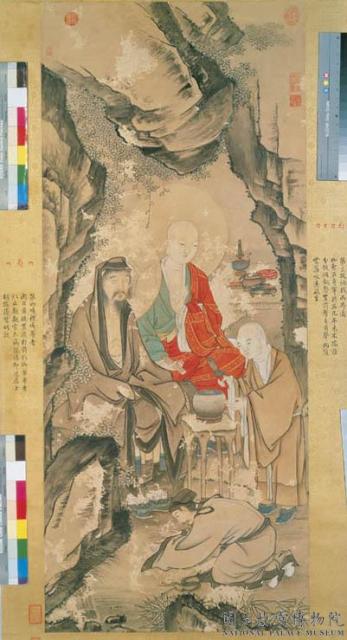清徐揚仿貫休畫羅漢 軸
推薦分享
資源連結
連結到原始資料 (您即將開啟新視窗離開本站)後設資料
- 資料識別:
- 故畫002840N000000000
- 資料類型:
- 類型:繪畫
- 型式:靜態圖像
- 著作者:
- 徐揚
- 主題與關鍵字:
- 佛道侍者 傢俱(屏風) 竹 供養人 香爐.火盆 宗教器用 羅漢(應真、尊者)
- 出版者:
- 數位化執行單位:國立故宮博物院
- 格式:
- 本幅 128.5x54.3公分、全幅 73公分
- 關聯:
- 故宮書畫錄(卷八),第四冊,頁125&*故宮書畫圖錄,第十三冊,頁329-330&* 徐揚,生卒年不詳,號雲亭,江蘇吳縣人,乾隆十六(西元一七五一)年,因獻畫而獲高宗賞識,召入內廷畫院為供奉。他的畫以山水為專長,又善於畫墨梅,人物畫較難得見到。 本幅畫二尊者結跏趺坐,其一眉目清淨,披袈裟,手持經卷,前一侍者持槌擊磬,另一尊者披髮長鬚,著長衫,閉目沉思,前一居士俯身跪拜。二尊者的後面石几上有水瓶、香爐、經卷等。全幅人物衣紋線條於勻稱,構圖平實,為清代畫羅漢典型之一。 &*Imitating Kuan-hsiu’s Paintings of Lohans, Hsü Yang (fl. 18th century), Ch’ing Dynasty. Hsü Yang (sobriquet; Yün-t’ing), whose birth and death dates are unknown, was a native of Wu-hsien, Kiangsu. In 1751, having presented a painting to the Ch’ien-lung emperor (r. 1736-1795) and receiving his praise, Hsü Yang was summoned to the Painting Academy of the Inner Court as a Palace Attendant. He was a specialist in landscape painting and also excelled at depicting plum blossoms in monochrome ink. His figure paintings are less frequently seen, however. This is a painting of two lohans seated cross-legged. One of them is handsome, dressed in monastic garb, and holding a sūtra scroll. In front of him is an attendant garb, and holding a sūtra scroll. In front of him is an attendant striking a ch’ing-instrument with a mallet. The other lohan wears long hair, a moustache and beard, and a robe with long sleeves. His eyes are closed in deep thought. Before him is a layman kneeling and bowing in worship. On the stone table behind the two lohans are such objects as a water bottle, incense burner, and sūtra scroll. The composition of the painting appears realistic. It is typical Ch’ing dynasty of lohans. &*1.李玉珉,〈清徐揚仿貫休畫羅漢〉,收入李玉珉主編,《羅漢畫》(臺北:國立故宮博物院,1990年初版),頁86。
- 管理權:
- 國立故宮博物院
授權聯絡窗口
- 國立故宮博物院圖像授權、出版授權、影音資料授權-申請流程說明
http://www.npm.gov.tw/zh-TW/Article.aspx?sNo=03003061






